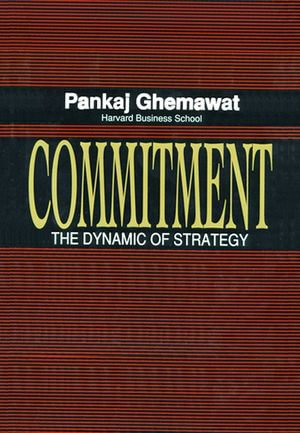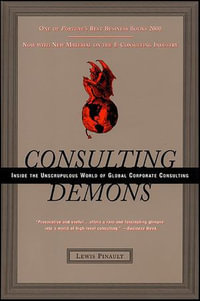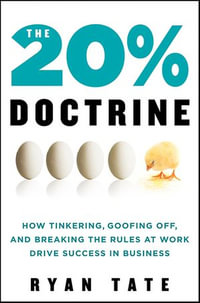
At a Glance
192 Pages
eBook
$27.99
or 4 interest-free payments of $7.00 with
Instant Digital Delivery to your Kobo Reader App
To create a competitive advantage, a company must commit itself to developing a set of capabilities superior to its competitors; But such commitments tend to be costly and hard to reverse. How then, should a company decide which broad path, or strategy, to commit itself to? And how are competition and uncertainty to be accounted for in that decision?
In this brilliant reassessment of how companies gain and sustain competitive advantage, Pankaj Ghemawat consolidates contemporary research in economics and other disciplines into a comprehensive yet practical framework for comparing commitments to strategically distinct options. This framework will help managers address specific strategic choices such as entry, exit, vertical/horizontal integration, capacity expansion, and innovation, as well as choices of generic strategy.
Step by systematic step, Ghemawat provides managers with the tools and techniques they need to improve the quality of the choices that they make. Specifically, Ghemawat discusses:
* how to identify the choices that are truly strategic -- that involve commitment -- before rather than after the fact
* how to analyze the short-run and long-run competitive positions implied by a particular strategic option
* how to assess the sustainability of superior competitive positions over time
* how to account for the flexibility afforded by a particular option in dealing with future uncertainties
* how to deal with both honest mistakes and deliberate distortions in the process of choice
This pathbreaking book will help managers invest in the future. Its logic applies to choices involving disinvestment as well as those involving investment -- and to choices that embody elements of both. Its logic can be used for diagnostic purposes, such as the valuation of business, and most broadly, it win force managers to think about important issues that they may have tended to ignore.
Ghemawat's discussion of these important ideas is concise, studded with detailed examples, based on rigorous research and, above all, practical. It will become required reading for thoughtful practitioners as well as practitionersto-be in the 1990s.
Industry Reviews
on
Contents
Preface
1. Strategy: The Failure of Success Factors
-- Strategy Has Come to Focus on Success Factors.
-- Success Factors Are a Shaky Foundation for Strategy.
-- The Failure of Success Factors Isn't Fatal to the Enterprise of Strategy.
2. Commitment: The Persistence of Strategies
-- I Define Commitment as the Tendency of Strategies to Persist over Time.
-- Commitment Is Crucial to Explaining Strategic Dynamics.
-- Commitment Is Caused by Lock-in, Lock-out, Lags and Inertia.
-- Commitment Is the Only General Explanation for Sustained Differences in the Performance of Organizations.
-- The Irreversibility Implicit in Commitment Necessitates a Deep Look into the Future.
3. Choice: Making Commitments
-- Commitment Complicates Choice.
-- Orthodox Approaches to Choice Do Not Help Managers Cope with Commitment.
-- Commitment Is Mostly Concentrated in a Few Choices.
-- Attention Should Be Focused on Commitment-intensive (Strategic) Choices.
-- Strategic Choices Demand Cost-benefit Analysis.
-- The Cost-benefit Analysis of Strategic Choices Can Partly Be Systematized.
4. Positioning: Creating Value
-- Reconsider the Launch of the Lockheed TriStar.
-- Positioning Analysis Compares the Costs Incurred and the Benefits Delivered by Strategic Options.
-- Positioning Analysis Can Usefully Be Reillustrated.
-- Positioning Analysis Is an Incomplete Basis for Strategic Choice.
5. Sustainability: Claiming Value
-- Sustainability Analysis Is Very Important.
-- The Sustainability of Superior Product Market Positions Hinges on Commitments to Sticky Factors.
-- Imitation Is a Direct Threat to the Scarcity Value of Sticky Factors.
-- Substitution Is an Indirect Threat to the Scarcity Value of Sticky Factors.
-- Holdup Threatens to Divert Scarcity Value.
-- Slack Threatens to Dissipate Scarcity Value.
-- Sustainability Analysis Should Be Integrated with Positioning Analysis.
6. Flexibility: The Value of Recourse
-- Reconsider the Replacement of Old Coke with New Coke.
-- Revisions Tend to Be Common.
-- Revision Possibilities Afford Flexibility Value.
-- Flexibility Analysis Should Be Integrated with Positioning and Sustainability Analyses.
-- The Integration Procedure Can Be Illustrated.
-- Flexibility Is Particularly Valuable in the Presence of Ambiguity and Learning Possibilities.
7. Judgment: Coping with Error
-- Errors in the Analysis May Be Either Honest Mistakes or Deliberate Distortions.
-- Consider Bidding Patterns on Offshore Oil and Gas Leases.
-- The Analysis Should Be Supplemented with Experience.
-- Experience Should Not Be Overemphasized.
-- Organizations Confront Trade-offs between Errors of Omission and Errors of Commission.
-- Different Organizational Arrangements Tend to Lead to Different Mixes of Error.
Notes
References
Index
ISBN: 9781439106174
ISBN-10: 1439106177
Published: 1st January 2000
Format: ePUB
Language: English
Number of Pages: 192
Audience: General Adult
Publisher: Free Press
You Can Find This eBook In

eBOOK
RRP $13.50
$11.99
OFF

eBOOK
RRP $25.99
$20.99
OFF

eBOOK
RRP $25.99
$20.99
OFF

eBOOK
RRP $25.99
$20.99
OFF

eBOOK
The 20% Doctrine
How Tinkering, Goofing Off, and Breaking the Rules at Work Drive Success in Business
eBook
RRP $28.99
$23.99
OFF

eBOOK
RRP $25.99
$20.99
OFF

eBOOK
RRP $24.99
$20.99
OFF

eBOOK
RRP $25.99
$20.99
OFF

eBOOK
RRP $28.99
$23.99
OFF















